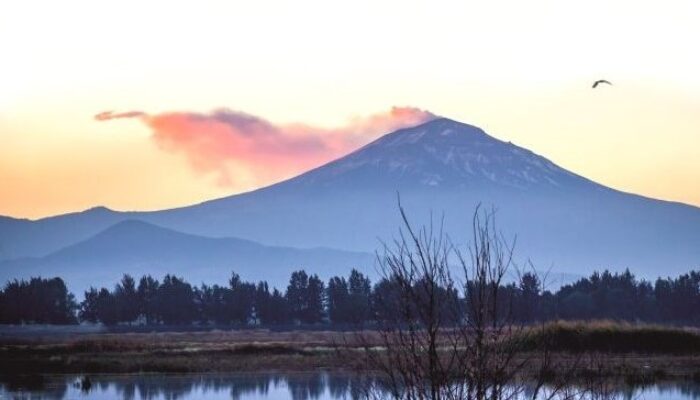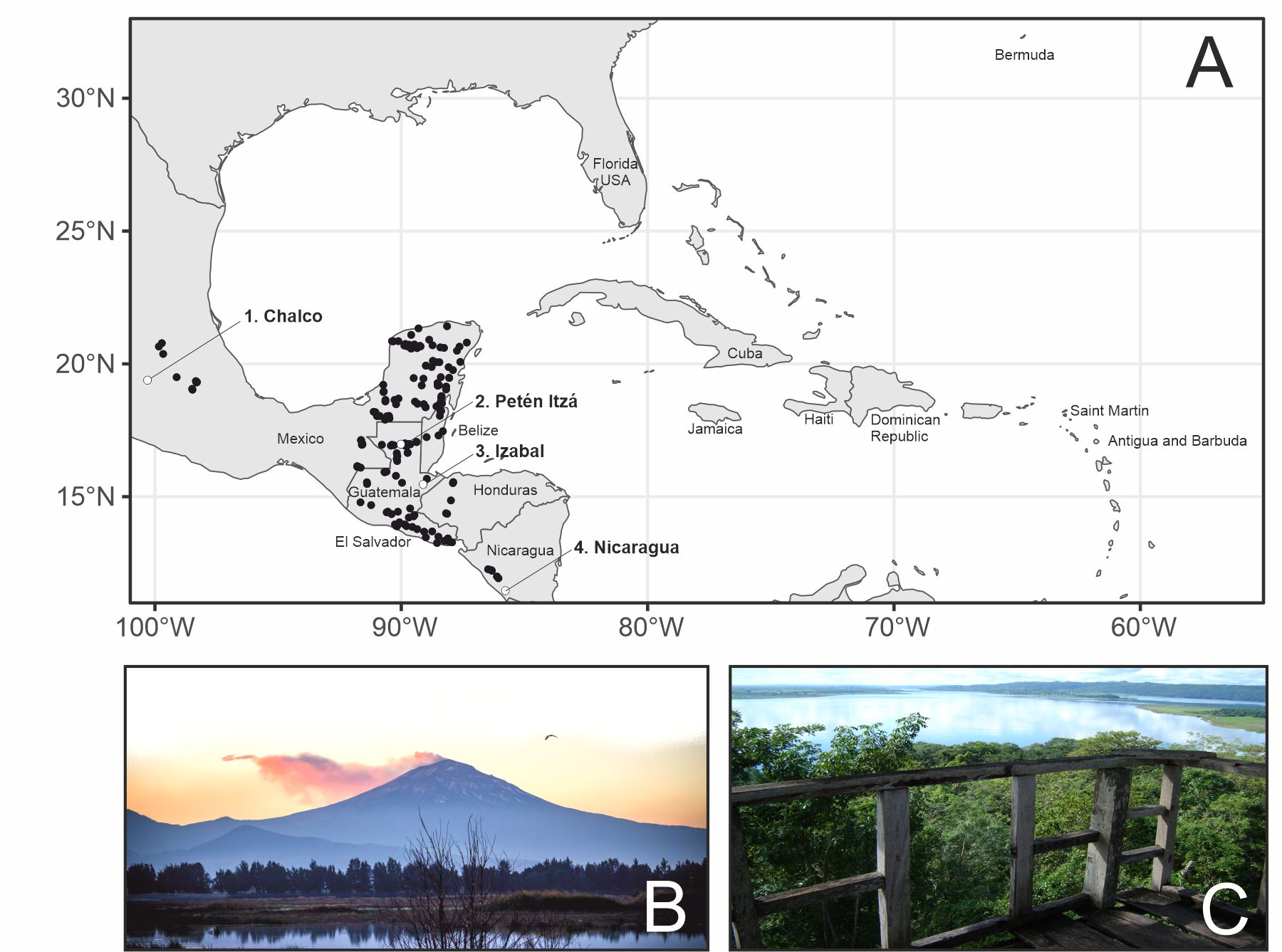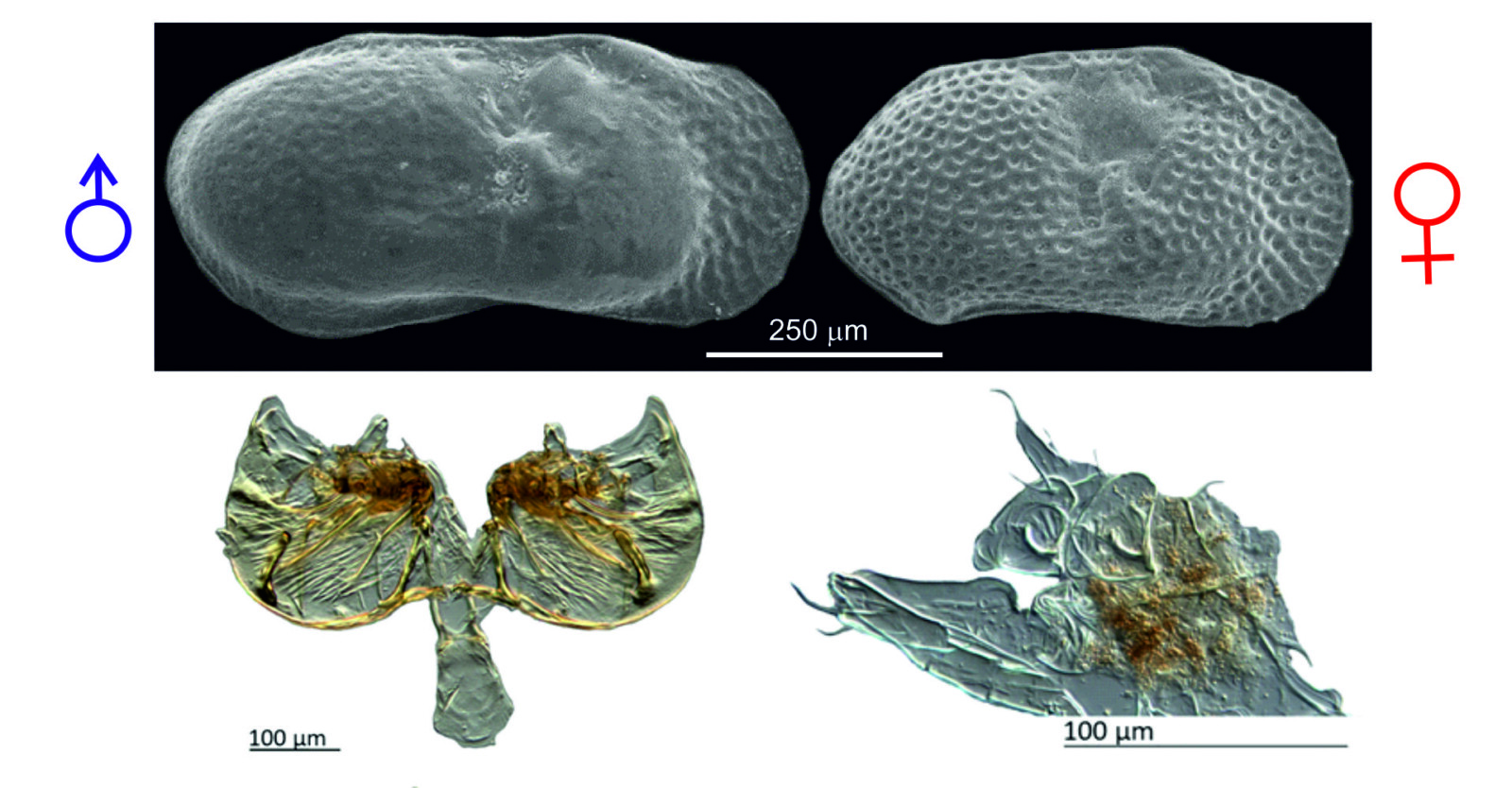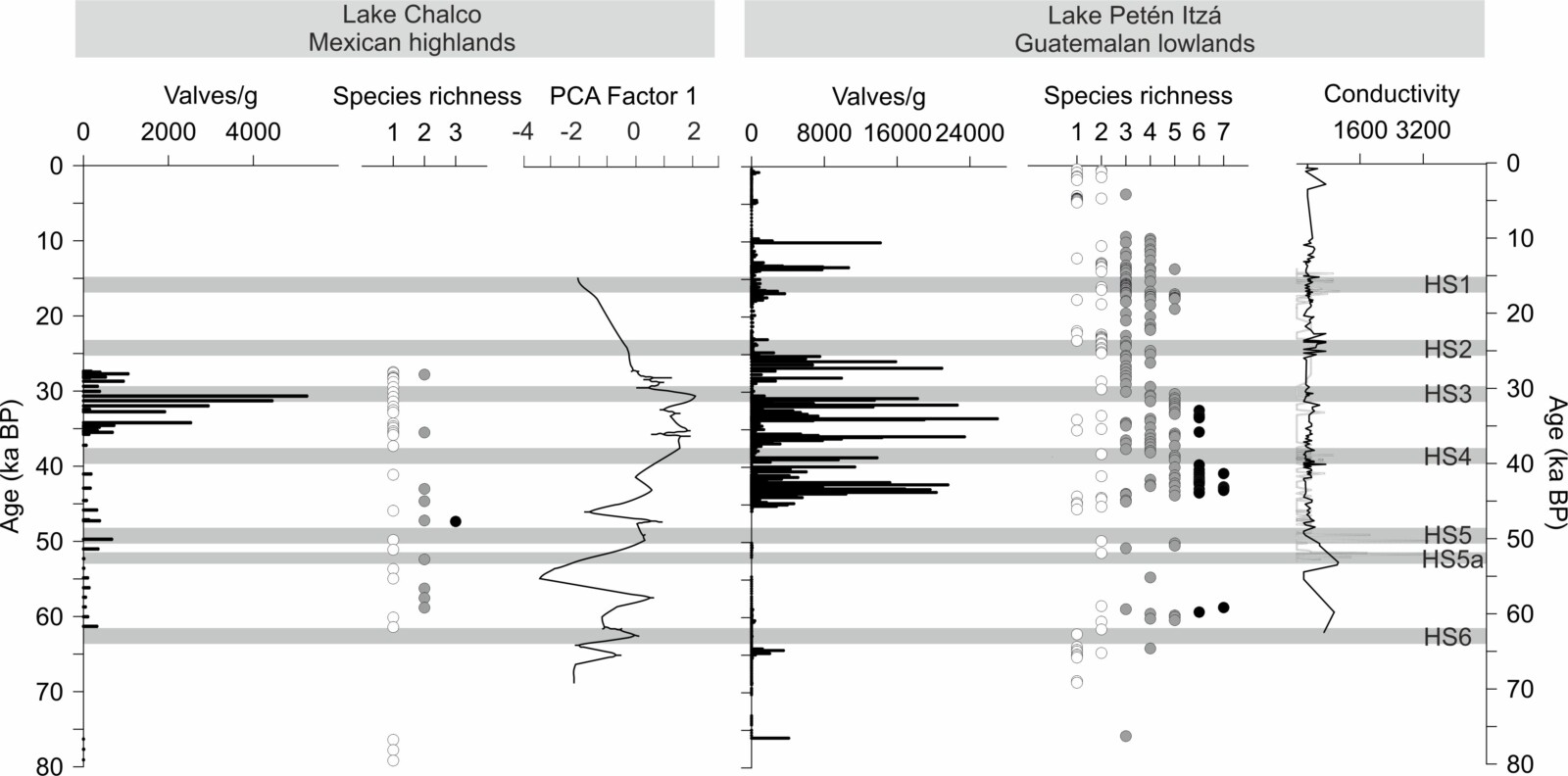
The North American Tropics hosts lakes of diverse origins and limnological characteristics, which are located along a broad altitudinal gradient, from 0 to 5675 masl. The region possesses several ancient lakes that have accumulated sediments continuously, in some cases for >400,000 years. Study of those lake deposits has enabled scientists to infer past climate and environmental conditions, as well as past changes in aquatic and terrestrial biodiversity. Four such ancient lakes have been identified in the region: Lake Chalco in the highlands of central Mexico, and Lakes Petén Itzá, Izabal and Nicaragua in the lowlands of Central America (Figure 1). Drilling operations carried out under the auspices of the International Continental Scientific Drilling Program (ICDP) recovered long sediment cores from Lakes Petén Itzá (110 masl) and Lake Chalco (2240 masl) in 2006 and 2016, respectively. Future drilling operations in Lakes Izabal and Nicaragua will enable study of even older deposits, probably extending back to the Miocene (ca. 10 Ma). Those sediment records will also be used to identify past climate conditions that are analogs of present and modeled future climate.

Figure 1. A. Location of ancient neotropical lakes: 1. Chalco; 2. Petén Itzá; 3. Izabal; 4. Nicaragua (white circles) and 175 water bodies (black circles) studied to determine limnological conditions and the ecological preferences of freshwater ostracodes in the North American Tropics. B. Lake Chalco, Mexico (photograph by Iván Martínez). C. View of Lake Petén Itzá, Guatemala.
This Neotropical region is sometimes referred to as a “biodiversity hotspot.” For Central America, this certainly applies to fish, but it may not be applicable to some freshwater invertebrate communities, such as microcrustaceans, as discussed below. Whereas microcrustaceans, such as ostracodes may not display high diversity, the resilient and adaptive species that occupy waterbodies in the region have survived abrupt climate and environmental changes over the last ~80,000 years.
Recorders of past changes in ancient lakes
Ostracodes, also known as mussel-shrimps, are bivalved crustaceans that have soft body parts enclosed within a carapace that is composed of two hinged shells (valves) made of calcium carbonate. The valves are often preserved well in lake sediments and are thus used frequently in micropaleontological studies of past climate and environmental conditions. The organisms are typically <5 mm long, have a benthic (bottom-dwelling) or nektobenthic (swimming near the bottom or substrates) lifestyle, lay eggs, molt, and generally have eight juvenile instars (A-8 to A-1), followed by the adult stage (Figure 2). Ostracodes can display sexual or asexual reproduction, or a mix of both. Some populations display geographic parthenogenesis, i.e., they develop from an unfertilized egg. This occurs among species that predominantly reproduce sexually in regions under highly variable environmental conditions, but maintain asexual reproduction in other geographic areas. Studies of limnological variables and ostracode taxa in 175 lakes from central Mexico to Nicaragua (Figure 1) revealed that freshwater ostracodes in the region are highly sensitive to environmental conditions, especially water-column conductivity, ionic composition, temperature, and depth (Echeverría-Galindo et al. 2019, Pérez et al. 2021, Macario-González et al. 2022).

Figure 2. Right shells (external view) and genitalia of a male and a female Paracythereis opesta from Lake Petén Itzá, Guatemala. Shells were found in sediments deposited during the Last Glacial Maximum (~23-19 ka). Genitalia (left: male hemipenes, right: female genital lobes) correspond to live individuals from surface sediment samples collected during the dry season of 2008 (Credits: Nora Kraatz).
80,000 years of biodiversity change in highland Lake Chalco and lowland Lake Petén Itzá
Compared to other ancient lakes such as Ohrid in Macedonia, which is home to 32 ostracode species (Lorenschat et al. 2014), species richness has been low in two studied waterbodies of the North American Tropics (≤ 9 spp. overall, maximum of 7 spp./sample) since the late Pleistocene (Figure 3). Ostracode abundances in lowland Lake Petén Itzá, however, have at times been high, as the lake has high concentrations of calcium, magnesium, and carbonate, which the ostracodes use to build their shells after each molt. In contrast, highland Lake Chalco displays lower abundance values, probably as a consequence of continuous changes in water alkalinity and trophic state (Moguel et al. 2021; Chávez et al. 2022), which likely affected shell preservation. Moreover, Lake Petén Itzá is much deeper (zmax = 165 m) than Chalco (zmax = 5 m) and therefore possesses a greater variety of microhabitats for ostracodes to occupy across the broad water-depth range.
Freshwater communities in the lowlands are very sensitive to changes in water conductivity and depth. For instance, colder and drier Heinrich stadials (HS6-1) were episodes of abrupt climate transitions characterized by lower water levels and higher conductivity, and both lower ostracode abundances and species richness in Lake Petén Itzá (Figure 3) (Pérez et al. 2021). Heinrich stadials were characterized mainly by higher alkalinity (PCA Factor 1) in Lake Chalco, and also lower ostracode abundance and species richness, except HS3, which was characterized by the highest ostracode counts.

Figure 3. The 80-ka ostracode records from Lakes Chalco in the Mexican highlands and Petén Itzá in the Guatemalan lowlands. Abundance values are given as valves/g, i.e., valves (shells) per gram dry sediment. Species richness is the number of species per sample (white: low, grey: medium, black: high). Statistics: PCA Factor 1: Principal Component Analysis with 29% of variance contribution is based on the relative abundance of ostracodes and diatoms (Chávez et al. 2022). Inferred past water conductivity values (microsiemens per centimeter) in Lake Petén Itzá were determined using a Weighted Averaging Partial Least Squares (WA-PLS) transfer functions based on a calibration data sets in Pérez et al. (2011) (black line), and Cohuo et al. (2018) and Macario-Gonzalez et al. (2022) (light grey dashed line).
Ostracode resilience and adaptation strategies in the American Tropics: Endemicity and sex matter
Low ostracode species richness in the Petén Itzá and Chalco records is probably explained as the consequence of continuously fluctuating climate and environmental conditions, which requires high resilience and adaptation. Most of the species that inhabit these lakes are endemic to the region (7 of 9 spp. in Petén Itzá and 2 of 3 spp. in Chalco). Another possible survival strategy is the predominance of sexual over asexual species. More than 90% of the species in the two sediment records display sexual reproduction, which achieves recombination and promotes genetic diversity within populations, enabling rapid adaptation to new environmental conditions.
Why are ostracodes important?
There are several reasons why lacustrine ostracodes are important. They (1) are primarily detritivores and filter feeders, and thus help maintain high water transparency, (2) play an important role in the decomposition of organic matter and nutrient cycling in aquatic ecosystems, (3) are bioturbators, and through sediment mixing, they provide oxygen and nutrients to other benthic organisms, (4) are calcifiers, and thus play a role in carbon storage, and (5) are prey items for several animal groups that occupy higher trophic levels, such as invertebrates (e.g., insects) and vertebrates (e.g., fish). Therefore, changes in their reproductive strategy, could impact the functioning of lake ecosystems and could potentially have consequences for artisanal fisheries, for example in Lake Petén Itzá. Although their life histories are relevant to the ecology of lakes worldwide, few studies have focused on reproductive strategies in this taxonomic group. Understanding both past and present dynamics of ostracode communities in these ecosystems is crucial for the sustainable management and conservation of aquatic ecosystems, especially in the context of ongoing climate and environmental change.
Acknowledgements
Nora Kraatz, Mathilda Schlecht, Paula Echeverría-Galindo, Mauricio Bonilla, Rodrigo Martínez, Sergio Cohuo, Laura Macario-González, Simone Schulze, Socorro Lozano, Margarita Caballero, Beatriz Ortega, Antje Schwalb, Frederik Schenk, Steffen Kutterolf, Thorsten Bauersachs, Mark Brenner and all our colleagues and institutions involved in the ICDP Projects PISDP and MEXIDRILL. Funding provided by ICDP, DFG, NSF, SNSF, CONACYT and UNAM.
References
Chávez-Lara, C.M., S. Lozano-García, B. Ortega-Guerrer, D. Avendaño, M. Caballero-Miranda. 2022. A Late Pleistocene (MIS4-MIS2) palaeohydrological reconstruction from Lake Chalco, Basin of Mexico. Journal of South American Earth Sciences 119: 103944. https://doi.org/10.1016/j.jsames.2022.103944
Cohuo, S., L. Macario-González, L. Pérez, F. Sylvestre, C. Paillés, J. Curtis, S. Kutterolf, M. Wojewódka, E. Zawisza, K. Szeroczynska, A. Schwalb. 2018. Ultrastructure and aquatic community response to Heinrich Stadials (HS5a-HS1) in the continental northern Neotropics. Quaternary Science Reviews 197: 75-91. https://doi.org/10.1016/j.quascirev.2018.07.015
Echeverría Galindo, P.G, L. Pérez, A. Correa-Metrio, C.E. Avendano, B. Moguel, M. Brenner, S. Cohuo, L. Macario, M. Caballero, A. Schwalb. 2019. Tropical freshwater ostracodes as environmental indicators across an altitude gradient in Guatemala and Mexico. Revista de Biología Tropical 67 (4): 1037-1058. https://doi.org/10.15517/rbt.v67i4.33278
Lorenschat, J., L. Pérez, A. Correa-Metrio, M. Brenner, U. von Bramannn, A. Schwalb. 2014. Diversity and spatial distribution of extant freshwater ostracodes (Crustacea) in ancient lake Ohrid (Macedonia/Albania). Diversity 6: 524-550. https://doi.org/10.3390/d6030524
Macario-González, L. A., S. Cohuo, P. Hoelzmann, L. Pérez, M. Elías-Gutiérrez, M. Caballero, A. Oliva, , M. Palmieri, M.R. Álvarez, A. Schwalb. 2022. Geodiversity primarily shapes large-scale limnology and aquatic species distribution in the northern Neotropics, Biogeosciences 19: 5167-5185. https://doi.org/10.5194/bg-19-5167-2022
Moguel, B., L. Pérez, L. Alcaraz, J. Blaz, M. Caballero, I. Muñoz-Velasco, A. Becerra, J.P. Laclette, B. Ortega-Guerrero, C. Romero-Oliva, S. Lozano, L. Herrera-Estrella. 2021. Holocene life and microbiome profiling in ancient tropical Lake Chalco, Mexico. Scientific Reports 11: 13848. https://doi.org/10.1038/s41598-021-92981-8
Pérez, L., A. Correa-Metrio, S. Cohuo, L. Macario González, P. Echeverría, M. Brenner, J. Curtis, S. Kutterolf, M. Stockhecke, F. Schenk, T. Bauersachs, A. Schwalb. 2021. Ecological turnover in neotropical freshwater and terrestrial communities during episodes of abrupt climate change. Quaternary Research 101: 26-36. https://doi.org/10.1017/qua.2020.124
Pérez, L., P. Frenzel, P. Hoelzmann, J. Escobar, M. Brenner, B. Scharf, A. Schwalb. 2011. Late Quaternary (24-10 ka BP) environmental history of the Neotropical lowlands inferred from ostracodes in sediments of Lago Petén Itzá, Guatemala. Journal of Paleolimnology 46: 59-74, https://doi.org/10.1007/s10933-011-9514-0
